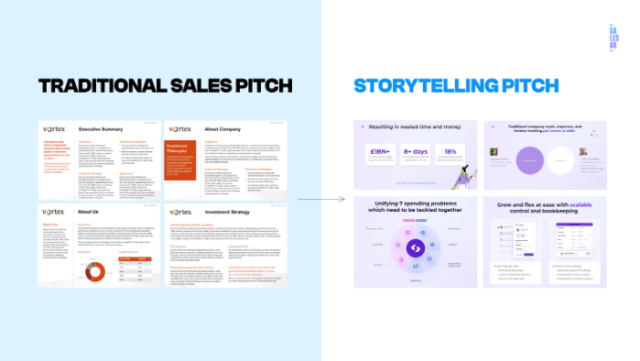
A business may have the best products or services, but without a powerful sales pitch to communicate this value, potential customers might never even consider the offer. A winning sales pitch can dramatically increase the effectiveness of your sales efforts, turning prospects into paying customers.
In today’s fast-paced world, where everyone’s time is precious, writing and delivering your sales pitch swiftly and effectively has become a very important skill. So, what if you could craft a compelling sales pitch in less time than it takes to finish your morning coffee?
Shifting From a Traditional Sales Pitch
Traditional sales pitches tend to follow a predictable format – a barrage of information about the product or service, with the assumption that the more you tell, the more you sell. However, this outdated approach has several disadvantages.
- Firstly, it risks overwhelming the potential customer with too much information, leading to decision paralysis.
- Secondly, it often ignores the potential customer’s unique needs and preferences, focusing instead on the features and benefits of the product or service.
Instead of this monologue-like approach, it is far more effective to engage the potential customer in a dialogue. This allows you to gain a better understanding of their needs and tailor your pitch accordingly.
For example, by asking insightful questions, you can uncover the challenges they are facing, which your product or service can help address. You can then focus your pitch on these specific issues, making it more relevant and compelling.
One way to make your pitch more engaging and memorable is by incorporating storytelling elements. Studies have shown that our brains are naturally wired to respond to stories.
We remember stories better than facts and figures, and we tend to feel more emotionally connected to the characters and events in a story. This means that by presenting your product or service as part of a story, you can make your pitch more engaging and memorable.

For example, instead of simply listing the features and benefits of your product, you could tell a story about a person who was facing a similar problem to the one your potential customer is facing, and how your product helped them overcome this problem.
This can help your potential customers visualize how your product or service could help them, increasing the likelihood that they will make a purchase.
As a lead generation company, this is a common practice for SalesAR when demonstrating previous case studies that are relevant to the prospect, whether for our own internal outreach or for our clients.
Nothing speaks like your previous achievements and successes, so find a way to include that in your messaging, whether it’s a sales pitch, an email, or a LinkedIn message.
In short, shifting from a traditional, information-heavy sales pitch to a dialogue-based, storytelling approach can greatly increase the effectiveness of your pitch.
Not only can this approach help you better understand your potential customer’s needs, but it can also make your pitch more engaging and memorable.
Understanding Your B2B Client
The first step in crafting an impactful B2B sales pitch is to understand your B2B client. Remember, an effective sales pitch in the B2B realm isn’t merely about selling a product or service – it’s about selling a cost-effective solution to a business problem.
Consequently, it’s vital to thoroughly understand who your clients are, their business challenges, and how your product or service can alleviate these challenges. Begin by characterizing your ideal client. Consider these key factors:
- Industry – Understanding the industry your client operates in can provide valuable insights into common issues they may face and the competitive landscape.
- Company size – The size of the company can indicate its needs and budget, with larger companies often requiring more comprehensive solutions.
- Business goals – Knowing the client’s business goals can help you align your product or service with their strategic objectives.
- Challenges – Identify the specific pain points your client is dealing with. These can become the central problems your product or service aims to solve.
By creating a well-defined profile of your ideal business client, you can customize your pitch to resonate with them on a more profound, business-centric level.
To unearth your clients’ needs and pain points, consider asking pointed, business-oriented questions. For example, if you’re selling enterprise-level project management software, you might inquire:
- “What challenges does your organization face in coordinating and executing projects?”
- “How much company resources, including time and manpower, are expended on project management tasks?”
These questions can help you identify the issues most crucial to your business client, enabling you to craft a pitch that directly addresses their unique business needs.
Creating a Persuasive Sales Script

Armed with your key selling points, understanding of the customer, and a well-formed pitch, the next step is to bring it all together in a compelling sales script.
Your script is the backbone of your sales pitch. it’s your go-to resource to ensure that you deliver a consistent, effective message each time. Here’s how to create it in less than ten minutes:
• Draft an Opening Statement – Start by crafting an opening line that grabs your customer’s attention. This could be a question about their needs, an interesting fact about your product, or even a short, relevant joke. Your opening statement should hook your customer’s interest and create a desire to hear more. Keep it brief, direct, and engaging.
• Define the Problem – Once you’ve gotten your customer’s attention, introduce the problem you aim to solve. Use the insights you’ve gathered about your customer to describe the issue in terms they’ll understand. This shows that you understand their pain points and creates an emotional connection with them.
• Introduce Your Solution – Now it’s time to present your product or service as the solution to the problem. Remember to focus on the benefits, not just the features. For example, don’t just say your project management software has a calendar feature. Explain how this feature can help your customer keep track of all their tasks and deadlines, saving them time and stress.
• Demonstrate Value and Credibility – Back up your claims with evidence. This could be a case study, customer testimonials, or statistics. Concrete proof of your product’s effectiveness strengthens your pitch and builds trust with your customer.
• Insert a Call to Action (CTA) – What do you want your customer to do after hearing your pitch? Whether it’s scheduling a demo, signing up for a free trial, or purchasing your product, be explicit about the next step. A compelling CTA creates a sense of urgency and encourages the customer to act.
• Practice, Edit, and Refine – Finally, once you’ve written your script, practice delivering it. As you do, pay attention to how it sounds. Are there awkward phrases or complex jargon that could be simplified? Is there information that isn’t necessary? Edit your script for clarity and conciseness. The aim is to create a compelling, engaging pitch that can be delivered in under ten minutes.
Creating a persuasive sales script is an essential part of crafting a winning sales pitch. It gives you a solid structure to follow and ensures that you deliver a consistent message every time.
By focusing on your customer’s needs, presenting your product as a solution, and demonstrating its value, you can create a sales script that grabs your customer’s attention and persuades them to take action.
Conclusion

In short, it’s essential to know your audience, create a persuasive structure, use hard data, and deliver your pitch with conviction and confidence. Without these elements, your sales pitch may not have the impact you desire.
But with these strategies in your toolbox, you are well-equipped to create a persuasive, engaging, and successful sales pitch, and you can do it all in less than ten minutes. The important part is not to rush but rather, to have a clear understanding and a well-crafted message.
We encourage you to apply these steps in your next sales pitch preparation. Evaluate your results, analyze what worked and what didn’t, and continue refining your approach.
Success in sales often comes from constant iteration and learning from experiences. With every pitch, you’ll improve, gaining more confidence, and becoming more effective in your sales strategy.














